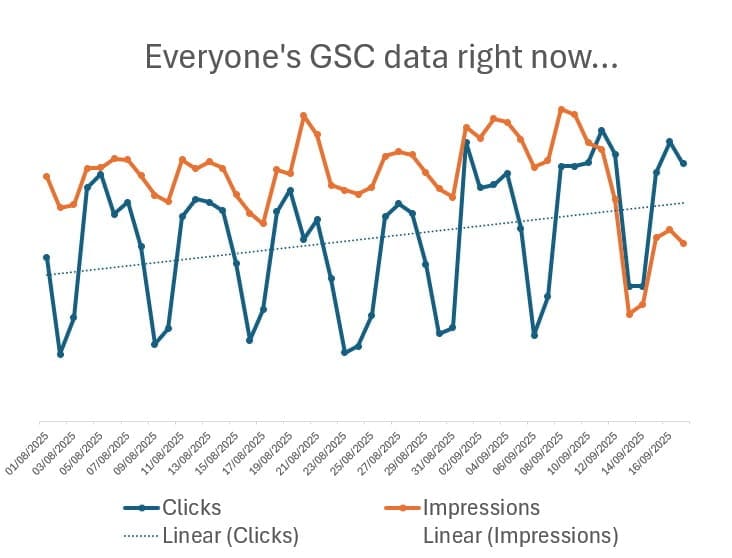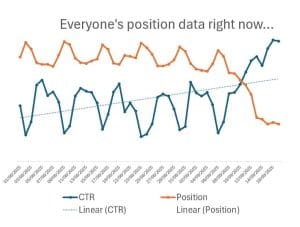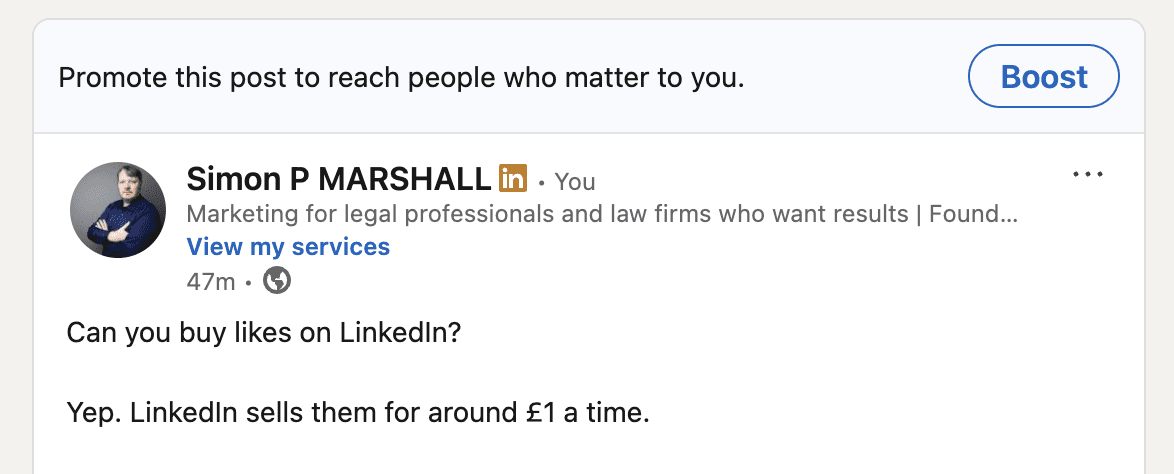Earlier this week, reports surfaced of an experiment Google’s been running – where it quietly removed support for the &num=100 parameter around the 14th of September.
The SEO community erupted overnight.
But for law firm marketers and leaders, the reality isn’t all that bad.

What this means for law firm marketers:
Your traffic and enquiries won’t change. What will change is the reporting. You’ll see fewer impressions in Search Console and slightly better “average positions.” It’s noise, not a drop in performance.
Competitor insight will be thinner. Most agencies won’t be able to track rankings past the top 20. Expect leaner reports and more focus on traffic.
This is a chance to drop vanity metrics. Rankings have never been a true reflection of client acquisition. This shift is a push to measure what matters: traffic, enquiries, and signed clients.
What to ask your agency:
- How are you adjusting our reports?
- Can we still see useful competitor data?
- How will we benchmark progress going forward?
Bottom line: nothing material changes for your firm’s marketing outcomes. Use this as a moment to reset — cut through the reporting noise, and make sure your agency is aligned to the metrics your partners actually care about.
What does this mean?
When you view the search results as a regular human being, you’ll likely see the ‘top 10’ results for your query, with a smattering of reviews, maps results, maybe an AI overview and other ‘rich’ snippets related to the category.
The &num=100 parameter lets you see not just 10, but 100 results – all in one go.
Without it, (for most tools) it’s thought that you will no longer be able to pull reliable ranking data, beyond the top 10-20, on your competitors.
Practically, many of these tools will need to multiply their crawling capability by a factor of ten to make up for this, which for many, is thought to be so expensive as to be unsustainable – so it’s more likely that the impacted tools will limit their reporting to the top 20 in future.
However, there are tools that do not rely on results scraping – and instead depend on APIs to source this data – so far, they’re thought to be unaffected; while some impacted platforms are said to be working on API workarounds.
Ahrefs, SEMrush and Sistrix are reported to be testing alternative data sources already.
What’s it used for?
A lot of SEO tools ‘scrape’ these top 100 results to provide insights and progress reports to in-house SEO’s, marketers, consultants and agencies, so they can see how ‘well’ their site ranks for a variety of keywords and phrases – and to see how their competitors rank for the same keywords and phrases.
Internal tracking
Most folks know that the goal is to be in the top ten for commercially useful phrases, e.g. ‘medical negligence solicitor’ – but if you’re not there already, it can be a long slog to the top.
If increasing your organic search visibility is one of your objectives, and you’re not in the top ten, you’ll want to see where you are now, and regular reporting that charts your (hopefully) steady rise to the top. So if you were already ranking around position #40 – you could see further improvements, or declines, even if your rankings were so low, no humans were likely to see you (yet).
Competitive spying
Charting your own progress is fun, but seeing where the competition are generating new content and getting traction is also useful – can you ‘borrow’ some of these approaches?
Have some key competitors lost some ground? If so, can you modify and build some pages to capture that traffic, and the resulting enquiries? Some fear that they’ll lose some insight.
How does this impact the SEO reporting from my team/agency?
There’s evidence that some rank tracking tools may artificially inflate the number of impressions in Google Search Console (GSC) as they generate queries for an immense number of keywords (it needs to search the query, to see the result, to report on website positions in the results) – ergo, inflating the number of impressions any business receives if they ‘rank’ for those phrases.
Consequently, you will see a drop in impression volume in your Google Search Console (GSC) data, and you will also see an ‘improvement’ in your average position. You are unlikely to see a material change to clicks or traffic volume as a consequence of this change – so it’ll be a reporting aberration, instead of a ‘drop’ in genuine performance.

Fortunately, it should mean that your client acquisition KPIs should be unaffected (unless you’re unlucky enough to see diminishing performance at the same time as this change) – but you will want to re-base any click-through rate (CTR%) measures (Impressions > click > site visit) if you’re using them.
It will make future month-on-month and year-on-year comparisons sketchy, so analysts may choose to adjust historic impressions manually, though for most businesses it’s simpler to focus on traffic trends instead.
If you lean on your marketing team or your law firm SEO agency for detailed competitor rank tracking beyond the top 20 positions, you can expect this to fall away – limited instead to just the top 20 positions. For more insight, your agency or team would likely need to change platforms, or spend more on new subscriptions – and that may not be worthwhile.
Instead, focus on what you can control – seek reports on your current average position, by query and by page, and compare this with traffic volume to those same pages – are things getting better? Or worse?
What should I do instead?
Either you’re an SEO, or you’re a marketing leader who’s accountable for organic performance – either way, it’s not all bad news.
Internal tracking
Google Search Console provides data on your ‘average position’ for a slew of queries – so it’s still possible to see how your site performs for specific keywords in the research results.
The challenge, is that this data is only stored for 16months – so multi-year comparisons won’t be easy – you’ll need to export this data to BigQuery or some other means of storage for this kind of ‘look back’; you could also export this data as .csv files and build up a history locally, if you don’t mind the faff. Although hardened SEO veterans would argue that with so much change happening within the search results, it’s tough to draw meaningful insights from multi-year ranking comparisons anyway.
In GA4, you can still see traffic to individual pages over time, from ‘organic’ as a channel – so you can see whether changes in average position are delivering meaningful growth in traffic to the pages you care about.
Competitive spying
This is harder. Many of the popular tools for this reporting (ahrefs / SEMrush etc) have responded to the news by saying something like: we are… “reviewing ways to adapt to this new environment while minimizing disruption to your workflows”.
But does it really matter?
Most of us know that the majority of traffic is in the top 10 positions, and we can still see those – so far, so good.
In positions 11-20 is where a lot of opportunity lies – you’re not far away from the first page, but you’re not capturing much traffic either, but this is where you can have a meaningful impact.
For many who are doing competitive research, this should still be directionally helpful, and you can still chart your site’s ranking progress via Google Search Console.
Practically speaking though, there are some instances where it doesn’t help.
Smaller sites without a strong ranking history will struggle to diagnose past performance if they don’t have a functioning GSC property — especially if they’ve slipped from positions in the 20+ range. In these cases, you’ll be relying more on GA4 traffic data to guide fixes, rather than isolating issues at a keyword level and page level based on past ranking fluctuations. So in some edge cases, it does mean you lose some insight – especially if you’re working with an older and/or smaller site.
What does this mean for the future of SEO?
There are varying perspectives on this.
First – for those of us paying for expensive SEO tools, those providers need to scramble to demonstrate value. We’ve grown quite attached to this reporting and we’ve just lost a chunk of it, but there’s no indication that the prices are coming down – if anything, they may need to hike them to restore a small proportion of what we’ve lost.
But being pragmatic, any SEO worth their salt is used to this.
SEO has changed and evolved and has always had to react to Google’s whims.
There are multiple ‘core’ updates a year that SEOs need to react to, and the overall direction of travel for Google has been to wrest control of data and insights away from 3rd parties, so that Google tools become the one source of truth, so you see only what they want you to.
Back in 2014, they removed all keyword data from Google Analytics overnight – and we loved that stuff – but the industry, and life, goes on.
Arguably, the practical application of ranking data has been challenged for a long time now. Many of us have been in a meeting, where someone has proudly stated “we now rank at position X for Y-keyword” – then everyone in the meeting pulls out their phone, they Google it, and lo – everyone sees a totally different set of results.
Rankings, as we measure them, have been divorced from user context for quite some time. As the search results adapt with a plethora of customised features, snippets and results – guided by individual location, search history and online behaviour – it has become increasingly difficult to translate rankings into value unless it delivers sizable increases in traffic and enquiries.
And this isn’t news, Mike King wrote about this back in 2020 – five years ago, the #1 organic spot could still have been the 9th option a user saw. What looked good on a report, in reality, should have been a cause for concern.
What should I do about it?
Not a lot.
Check in on your SEO team – changes like these are a pain, and you can guarantee their inboxes are full of questions and sharp assumptions that can be more of a headache to answer, than dealing with the actual thing that sparked the queries in the first place. Have a chat with them, make sure they’re alright.
Check in on your reporting – you’ll see a lot of volatility in your Google Search Console reports just now, many in the community are reporting a drop in impressions, particularly for short keywords, and a corresponding rise in average rankings. Don’t worry, it’s likely that most of what you’ve lost are impressions from bots, and what you’re seeing now may be closer to real human behaviour (although we’re still waiting on confirmation from Google on this) – this is likely to be your new normal – so treat this as the new baseline for future reports.
Check on your tooling – is it principally used for highly detailed competitive rank tracking? If so, does the cost still make sense if you’re likely to lose this? – Don’t throw the baby out with the bathwater though, these tools still have a lot of other uses.
Re-examine the wider marketing plan and strategy – for years now, good SEOs have known that on-page tweaks and new content will only take a business so far. Wider exposure in the press through good PR helps; while advertising and embedding the brand in the minds of more people means that they’re more likely to click you (the brand they’ve heard of) when they see you in the search results. A monolithic digital strategy in 2025 is a sure-fire way to lose market share and revenue.
The bottom line is that everyone’s been impacted in the same way, so no one is ‘winning’ out of this (except for Google) – so adapt and move on. For law firms, that means cutting through the reporting noise and keeping the focus where it belongs: genuine traffic, enquiries, instructions, and building a brand clients trust.
If you’re still looking for assurances, or would like some SEO audits running, just to ‘make sure’ – get in touch, we’d love to help
If you’ve been impacted by the change, I want to hear from you – drop me note at: john.king@2bd.me
Sources
- https://searchengineland.com/google-search-rank-and-position-tracking-is-a-mess-right-now-461984
- https://www.searchenginejournal.com/google-modifies-search-results-parameter-affecting-seo-tools/556080/
- https://ahrefs.com/blog/google-serp-changes-update/
- https://www.semrush.com/news/424322-google-changes-to-serp-data-collection-what-you-need-to-know
- https://www.sistrix.com/blog/more-work-new-chances-how-googles-update-changes-serp-measurements/
- https://serptag.com/blogs/rank-tracking-tools-that-survived-googles-num100-removal
- https://www.vibelogic.com/post/google-broke-rank-tracking-but-theres-more-to-it-than-that
- https://www.searchenginejournal.com/the-future-of-rank-tracking-can-go-two-ways/556399/
- https://ipullrank.com/organic-search-rankings-v2






